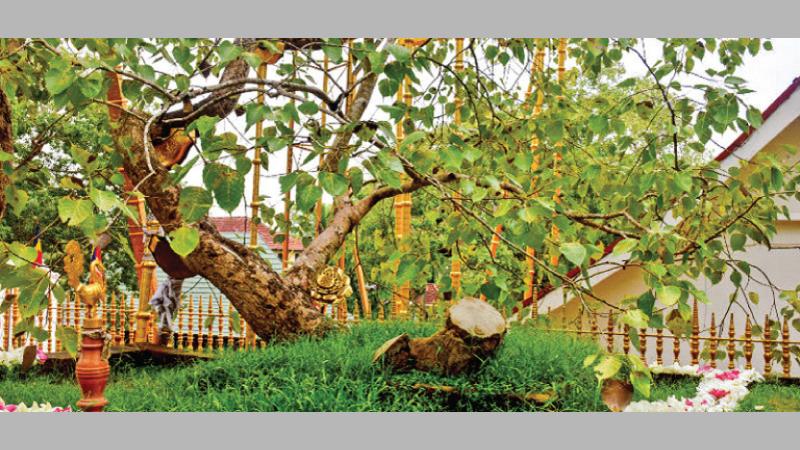
The Jaya Sri Maha Bodhiya
The Jaya Sri Maha Bodhiya takes a place of utmost importance in the history of Sri Lanka. It is the oldest human-planted tree in the world with a known planting date, as well as the main reason for the historical city of Anuradhapura to become a Sacred City. The Jaya Sri Maha Bodhiya belongs to the family of trees known as asvastha in Sanskrit, asvattha in Pali and aesatu in Sinhala. Botanists have named it ficus religiosa taking its religious importance among Buddhists, Hindus and Jains into account.
This sacred tree was planted in the Maha Meghavana Royal Park in Anuradhapura in the month of Unduvap (December), 236 BC, according to historical facts which prove that this historical fig tree is over 2200 years old.
 An aesatu tree
An aesatu tree
About 2,600 years ago, the ascetic Sidhuhath sat with his back against an aesatu tree on the banks of the Neranjana River in Bodhgaya, India. It was at this moment, as he sat against the tree, that the ascetic Sidhuhath is said to have achieved enlightenment. In doing so, the tree also gained a status of veneration. It became known as the Bodhi tree, and pilgrims came to worship it even during the lifetime of the Buddha.
Sanghamittha Therini
Later, in 236 BC, Sanghamittha Maha Therini came to Sri Lanka on the instructions of the Emperor Asoka of India. She brought the Southern branch of the original Bodhi tree, which was ceremoniously presented to King Devanampiyatissa. His reign is an important milestone in the Anuradhapura era since Buddhism was brought to Sri Lanka by Mahinda Thera during this time.
Handing the Bodhi sapling to King Devanampiyatissa
There exists a strong belief among Buddhists that offerings made to the Jaya Sri Maha Bodhiya have produced significant, life-changing positive effects on them. Many Buddhist pregnant mothers make a special vow before the Jaya Sri Maha Bodhiya for the safe delivery of their babies without malformations.
People also make vows for many other cures. It has also been a long tradition among farmers in the North Central Province (where the Jaya Sri Maha Bodhiya is located) to offer the Jaya Sri Maha Bodhiya the rice prepared from their first paddy harvest.
They strongly believe that such offerings lead to sustained high paddy production with minimum damage from drought as well as pest attacks, including damages by elephants.

Serious threats
The Jaya Sri Maha Bodhiya has faced serious threats, not only from wild elephants and other animals who live in the vicinity of the sacred Mahavihara. Two storms in 1907 and 1911 resulted in broken branches.
A vandal attacked the tree in 1929, hacking off another branch. The Jaya Sri Maha Bodhiya, however, remains standing, as revered as ever in its 2300-year-long history. And as long as it continues to stand, it will remain the oldest cultivated tree in the world with a documented history.
The Kalutara Bodhiya
The Kalutara Bodhiya is in Kalutara, on the Galle-Colombo Road by the side of the Kalu Ganga, South of the city of Kalutara. It is believed to be one of the 32 saplings of the Jaya Sri Maha Bodhiya in Anuradhapura, Sri Lanka. A Buddhist temple, Kalutara Vihara and a modern stupa, the Kalutara chaitya are in close proximity to this sacred Bodhi tree. One of the most venerated religious places in Sri Lanka, hundreds of local Buddhists as well as foreign tourists visit this den of tranquility daily.
The Sinhala Bodhiwamsa
According to the ancient Ceylonese chronicle, Sinhala Bodhiwamsa, 32 saplings of sacred figs, which had sprouted from the Jaya Sri Maha Bodhiya were planted in various parts of the country as instructed by Arahath Mahinda Thera. The chronicle states that the Kalutara Bodhiya existed intact till the 15th century AD.
After the Portuguese took control of the coastal provinces of Sri Lanka in the 16th century, the site of the Kalutara Bodhiya was converted into a fort probably due to the strategic importance of its location on the south-western coast of Sri Lanka. The Dutch and the English, who succeeded the Portuguese as colonial rulers of Sri Lanka, also used the Kalutara Bodhiya premises for administrative and military purposes.
A protest
During the 1800s, when the British rulers started the construction work of railways in Sri Lanka, a decision was taken to cut the Bodhi tree as it was an obstruction for the planned railway bridge. Immediately, Upasaka Mahatmaya Sendanayake, a pious devotee who had played an immense role in restoring the Bodhi to its original glory, planned a protest with posters against the cutting the Bodhiya.
When the day dawned to cut the Bodhi, The Assistant Government Agent of the time, Brodhurst arrived with his officials to the scene only to face an angry mob armed with clubs, knives and mammoties.
The Assistant Government Agent sought police assistance from the Kalutara police.
The police warned the protestors to leave , but the protesters did not move and had to face charges of unlawful assembly.
However, their brave actions ultimately brought this issue to the notice of Queen Victoria who ordered the protection of all Buddhist landmarks and heritage sites and thus saved the Kalutara Bodhi from the English axe.
An icon
During its long history, the Kalutara Bodhiya has served as
an icon of local Buddhist devotion and this sacred tree has stood the test of time, the reign of many ancient Sri Lankan Kings as well as colonial rule.
Dinara Hettiarachchi
Grade 9
Ananda College, Colombo
